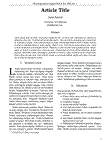Resultados de búsqueda - (((logue OR ((luque OR blaques) OR roque)) OR ligur) OR ligule) 1
Materias dentro de su búsqueda.
Materias dentro de su búsqueda.
- 1
- Antioxidantes 1
- Antioxidants 1
- Maíz azul 1
- antocianinas 1
- botanas de tercera generación 1
- calentamiento por microondas 1
- carne 1
- educación 1
- educación superior 1
- estudiantes 1
- extrusión-cocción 1
- frijol negro 1
- generación z 1
- guava 1
- guayaba 1
- meat 1
- multimedia 1
- oxidación 1
- oxidation 1
- rancidez 1
- rancidity 1
- seguridad informática 1
- software 1
- tecnologías 1
- universidad 1
-
21
-
22
-
23
-
24
Gender and live weight on carcass and meat characteristics of donkeys
Publicado 2018Enlace del recurso
Artículo -
25
-
26
Mineral content in four browse species from Northeastern Mexico
Publicado 2014Enlace del recurso
Artículo -
27
Importancia nutrimental en plantas forrajeras del matorral espinoso tamaulipeco
Publicado 2012Enlace del recurso
Artículo -
28
-
29
-
30
-
31
-
32
-
33
-
34
Xylem water potentials of native shrubs from northeastern Mexico
Publicado 2011Enlace del recurso
Artículo -
35
-
36
-
37
-
38
-
39
A new species of Perinereis (Polychaeta, Nereididae) from Florida, USA, with a key to all Perinereis from the American continent
Publicado 2013“…The new species can be distinguished from P. brevicirrata by the absence of a notopodial prechaetal lobe, Area V with 3 cones in a triangle, and Area VII-VIII with two well-defined rows of 33 paragnaths, the basal row having longer paragnaths in relation to the distal ones. The new species resembles P. singaporiensis based on the absence of notopodial prechaetal lobe; however, the two species differ in some morphological characteristics such as tentacular cirri length, shape of dorsal notopodial ligules, and falciger blades. …”
Enlace del recurso
Artículo -
40
A new species of Perinereis (Polychaeta, Nereididae) from Florida, USA, with a key to all Perinereis from the American continent
Publicado 2013“…The new species can be distinguished from P. brevicirrata by the absence of a notopodial prechaetal lobe, Area V with 3 cones in a triangle, and Area VII-VIII with two well-defined rows of 33 paragnaths, the basal row having longer paragnaths in relation to the distal ones. The new species resembles P. singaporiensis based on the absence of notopodial prechaetal lobe; however, the two species differ in some morphological characteristics such as tentacular cirri length, shape of dorsal notopodial ligules, and falciger blades. …”
Enlace del recurso
Artículo

